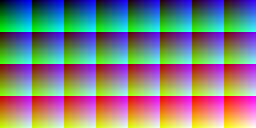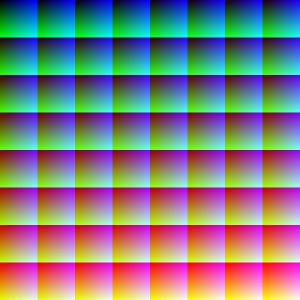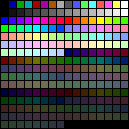Recently, a friend who shall remain anonymous said to me he wanted to draw some pixel art and would set Aseprite to use the NES color palette because it didn’t have a SNES one.
I was quite amused by this because there is no such thing. The NES, SNES, and IBM PC-Compatible with a VGA card all have one thing in common in that they have program-specifiable palettes. On the NES, you can pick some 28 colors by my count from a fixed master palette:

This isn’t even necessarily correct because of how these colors are generated but whatever. On the SNES though? You have a 256-color palette space, split in 16 rows of 16 colors each. The first of each row is considered transparent (leaving out mode-specific stuff for simplicity) and the final background color behind all the layers is the top-left one. Also, the bottom half is reserved for sprites.
But what do you assign to them? 256 of these bad boys:

Each entry is a 15-bit RGB value, ignoring the 16th. In other words, you have 32.768 different possible colors to pick and choose roughly 256 from. The palettes in Aseprite, or really any graphics editor that has an “indexed” mode, only go up to 256 entries.
On the venerable VGA graphics card so widely used in IBM PC-compatibles and still emulated by even the latest powerhouses, you get as many colors but this time you can use all of them at once. And they’re not even 15-bit but a whopping 18, for an impressive 262.144 different shades to pick from:

Still, you’d actually have more of a point speaking of “the” VGA palette. When a SNES boots up there’s no telling what’s in the palette RAM, but when a PC boots up, you know the VGA palette will default to this:

For both SNES and PC though, you’d be better off speaking of specific applications, games, or scenes in games. For example, here’s the default from DeluxePaint:

So just like how you can refer to “the” VGA palette, you can have “the” DeluxePaint palette.
Nicole remarked on Twitter that I missed an opportunity to mock the Genesis. Here ya go, ma’am.
![]()
Nine bits, 512 possible colors, 64 at once in memory but only 61 effectively because the first one’s transparent like on the SNES. Here’s the SNES again for easy comparison:








